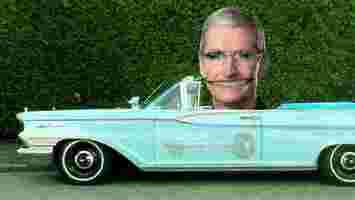We might see an Apple car this decade — here’s what we know
After years of speculation and long spells of silence, we finally got a bunch of Apple Car-related news last night. First, Bloomberg reported that Apple has a small dedicated team developing drive systems, vehicle interior, and external car body designs — but it’ll take at least half a decade to ship a unit.

Separately, Hyundai said in a statement to CNBC that it’s in early talks with the iPhone maker to build a car for it:
Later, the company toned down the statement and said they’ve been “receiving requests of potential cooperation from diverse companies.”
Hyundai has already set up a $4 billion joint venture with Aptiv, a company that provides automotive solutions, with the aim to roll-out self-driving platforms in 2022 . The South Korean car giant intends to mass-produce automated cars with level 4 and level 5 certification by 2024.
Bloomberg’s story points out that Apple is exploring two possible paths to jump into the mobility sector: building its own car and building a self-driving system for third-party vehicle makers.
Apple’s journey to produce a transport solution has been rocky. The company started out exploring solutions for a car in 2014 — with Tim Cook confirming the project in 2017 . However, two years later, in 2019, the firm laid off 190 employees working on the project .
Now, the project seems to be back with new vigor and changed vision. Last year, Reuters reported that Apple’s targeting 2024 to unveil its car solution. But if we go by Bloomberg’s latest report, we might see it a few years later.
Apple has hired a ton of engineers from reputed auto companies such as Tesla, Waymo, and BMW. Bloomberg also notes that the company is tuning its ARM-based chip for use in vehicle-based machine learning, and has a lofty goal to enable autonomous driving as well.
The Cupertino-based company has traditionally had an advantage of vertical integration, as it’s developing software and hardware solutions for its offerings in-house. Continuing with this strategy could lead to great profit margins for the firm. Analysts from Morgan Stanely believe that if Apple manages to capture even 2% of the auto market , its car business would be as valuable as its iPhone operations
Given Apple’s success in hardware, it’s easy to think that the company’s going to rival giants such as Tesla and General Motors right out of the bat. However, car manufacturing is a different ball game, and just like Tesla, the iPhone maker should be ready for several unexpected delays and manufacturing challenges.
Nonetheless, the idea of Apple Car sounds exciting and we can expect some unique solutions from the company that might change industry norms. But for now, we wait.
SHIFT is brought to you by Polestar. It’s time to accelerate the shift to sustainable mobility. That is why Polestar combines electric driving with cutting-edge design and thrilling performance. Find out how .
The top 5 EVs you should be excited for in 2021
This past year was slated by some to be the “year of the EV.” Having seen a number of new electric vehicles reach the market, it’s certainly been a very positive year for electrified cars — even despite the global pandemic.

Here at SHIFT, we think that in 10 years time — when gasoline vehicles are banned — we’ll look back on an entire decade of EVs that will be worth remembering. There will be highlights for sure, but we doubt that one year alone will stand out among the rest.
Why? Because 2021 will be another year that we see many more exciting and futuristic EVs unleashed into the wild. Here are the ones we’re looking forward to most.
Trucks, trucks, trucks
2021 is going to be the year that electric trucks could transcend their CAD designs and finally hit our roads. Honestly, we could probably write an entire article about electric trucks, but here’s the one we’re really looking forward to.
In 2021, we should finally see the Rivian SUVs hit the roads. On a personal note, this is probably my highlight for the year, Rivian if you’re reading this… get in touch please.


Anyway, the Amazon-backed company is set to release its R1S and R1T sports utility vehicles towards the backend of the year. They’ve been engineered from the ground up to be electric vehicles, and take advantage of all the space that comes as a result of not needing huge engines, drivetrains, and differentials.
While the Rivians are nowhere near as striking as Tesla’s Cybertruck and likely won’t have the road presence of the electric Hummer, they are thoughtfully designed, with function and performance coming ahead of form.
In the world of electric trucks, they could be a force to be reckoned with.
Mainstream electric with Volvo
Despite having close relations to electric focused brand Polestar, Volvo is yet to really enter the mainstream with an all-electric vehicle of its own.
That looks set to change in 2021 as the Swedish marque prepares to launch its debut all-electric vehicle, the XC40 Recharge P8.
Underneath it shares much of the running gear of the Polestar 2 , which I can tell you first hand is no bad thing.
The real reason we’re excited about this EV though is how it comes together as an entire package.
With over 250 miles (400 km) of range, an ability to charge from zero to 80% in 40 minutes, and 402 horsepower, in an SUV form factor, it stands to be the perfect recipe for an eco-conscious family wagon.
Deliveries are expected in the first quarter of 2021.
Another all-electric SUV… from BMW
BMW is no stranger to electric vehicles, its i3 feels like it’s been around forever and still holds up today. The German marque hasn’t put out a new EV since the i3 launched back in 2016 and it’s long overdue.
The motor company has been making plenty of noise though, with its iNext vehicle ever on the proverbial horizon of “the cars of tomorrow.” Until then, BMW is attempting to satisfy our lust for motorized volts with its iX3 SUV .
This vehicle will go toe to toe with the Volvo XC40 Recharge, featuring 285 miles (455 km) of range, and 282 horsepower. So it might be a little slower, but that premium BMW feel is guaranteed.
Like the XC40, the iX3 stands to be incredibly popular among families or drivers that favor the high riding position and extra space afforded by its large boot.
The BMW iX3 was officially unveiled earlier this year , and is expected to make its on the road debut in the middle of the 2021.
A new chapter for Nissan
Like BMW, Nissan hasn’t done anything properly new in the electric car market for quite a while. That is despite its Leaf EV being one of the most popular options on the market.
Anyway, in 2021 we should get the Ariya, the second all-electric vehicle from Nissan, and it’s another crossover SUV type thing. There’s a bit of a theme appearing here isn’t there?
It’s set to go on sale in the second half of 2021. When it does, it’ll feature up to an 87 kWh battery. The top of the range e-4orce model is slated to produce 389 horsepower.
Perhaps the best thing about the Ariya though, is that it’s going to use the CCS charging standard for fast-charging. The Nissan Leaf used CHAdeMO, which isn’t as widely supported in Europe as CCS .
I’m not surprised there are so many electric SUVs coming to the market. Now that most major brands have wrapped their heads around producing electric drivetrains it was only a matter of time until they plonked on a high-riding, spacious body. SUVs are popular, if it’s a way to get the masses behind the wheel of electric cars, it’s a step in the right direction.
Maybe 2021 will be the year of all-electric SUVs.
Small is also cool
No one wants to sound like a broken record, so let’s change our tune and give some time to the small and always adorable Fiat 500e.
This year saw a handful of other small electric hatchbacks come to market, the VW ID.3, the Mini Cooper SE, and the Honda e being three of the most talked about.
Next year, we should finally get to see the electrified version of the Fiat 500e reach market.
Compared to the massive SUVs above, the 500e won’t set your pants on fire, but that’s not the point. It’s meant to be a nippy, fun, and practical daily run about.
With a 43 kWh battery pack and around 200 miles of range, it beats the Honda e and electric Mini. Or rather, it should do when it finally hits the roads.
The 500e is expected to go on sale in the first quarter of 2021, and hopefully deliveries shouldn’t be too far behind.
So much more to come
This is by no means an exhaustive list of all the EVs coming in 2021, if you’re looking for that, check out this one from Autocar .
Some honorable mentions for EVs that have us tickled under the hood that we didn’t mention are: The Skoda Enyaq iV, the VW ID.4, the Tesla Model S Plaid, and the Mercedes-Benz EQV electric van.
This wasn’t an easy list to put together. There’s a lot to be excited about in the world of EVs in 2021. But if I had to put money on it, electric SUVs will be the talk of the town for most of the year.
SHIFT is brought to you by Polestar. It’s time to accelerate the shift to sustainable mobility. That is why Polestar combines electric driving with cutting-edge design and thrilling performance. Find out how .
Should I rant about climate change while also being a frequent flyer?
The last couple of weeks have been momentous for politicians, community and religious leaders, and activists as they flew to attend COP26 to stop the world imploding into doomsday scenarios .

No sector was safe — transport, overpopulation (ok, maybe not a sector per se), meat and dairy, or forest logging — from the ire of people desperate to assign blame.
One thing that attracted plenty of wrath is flying — and I’m part of the problem.
Private jets are bad, m’kay?


It’s no surprise that flying private jets has a heinous impact on the environment. According to The Daily Record , over 118 jets carried world leaders and business executives to COP26. This blasted 13,000 tonnes of CO2 into the atmosphere, over what 1600 Scottish households burn through in a year.
But anyone who thinks we’ll see Joe Biden, Prince Charles, or Jeff Bezos sitting in cattle class with the rest of us is dreaming.
I’m not sure what’s wrong with the pointy end of the plane, though. They won’t have to binge-watch Game of Thrones in the middle seat.
By the way, according to Check Your Facts , the photo used in the tweet above actually depicts aircraft parked at the New Orleans Lakefront Airport in 2013 for Super Bowl XLVII. During the event, New Orleans-area airports hosted more than 800 private aircraft for the game.
If this isn’t a blatant disregard for the climate, then I don’t know what is.
Is it time to stop business flying?
Ok, the bigger issue is, should we stop business flights altogether?
Politicians, in general, are big fat hypocrites. A UK report recently found that ministers and civil servants took nearly 107,000 domestic flights in Britain in just one year, an average of 293 flights a day.
That’s a lot of meetings that could have been an email.
Yes, I am a frequent flyer
I am guilty of being a frequent flyer.
In 2019, I took about 20 flights. Most were within Europe, the UK, and trips to Israel, Japan, Australia, and Hong Kong. The vast majority were work trips where I attended conferences on behalf of publications. It was fun. I hung out with some amazing devs, startups, companies, hackers, and general tech nerds.
But I also got to visit my family in Australia (which took six flights altogether). My parents are old, so they can’t fly halfway to reduce the burden or visit me — I’ve seen them three times since 2014. Travel to Australia is expensive and time-consuming.
While the last year has taught us that we don’t need to attend every event in person, it’s also taught us that we like attending events in person. Strange things happen!
There’s nothing like sitting with a bunch of crypto journos as they tell you how they’re going to stitch up Vitalik Buterin in a press room at a conference.
I also rather enjoyed listening to someone from Berlin going for a job interview at a startup at the table next to me in Hong Kong, slagging off his hopefully former CEO. (Don’t do your interviews in cafes, folks.)
You don’t know desperation until you see a horde of tech journos fighting for calamari at a press event. Or amusement until you see an American pitching anal sex toys to a room full of VCs.
You just don’t get this stuff on a zoom call.
But it’s not only these weird interactions that we miss without travel.
The impact of COVID-19 not only meant staying at home, but it also meant that, like many people, I missed weddings and funerals. Getting up at 3 am to watch a funeral online back in Australia wasn’t a great experience.
The luxury of time vs. money
You often see articles where people pledge to stop flying. One thing these people have in common who pledge low-fly commitments is the luxury of time. They’re usually not American, in jobs where you get 14 days annual leave a year.
Or from Melbourne, 30 hours door to door to get to Berlin.
In case you are wondering, I looked up traveling by boat to Australia (legally). From the Netherlands, it takes about 42 days . If you want me to write about this, donations are welcome!
Is it time for a tax on flying?
There is no tax on jet fuel — the only fossil fuel banned from being taxed by international treaty.
One idea from a campaign called A Free Ride is to tax frequent flyers (yep, that includes me). These are the 15% of flyers who take over 70% of all flights. They assert that the strongest predictors of frequent flyer status are ownership of a second home abroad, and household income of over $135k — this is not me.
The dream of Aviation Beyond Borders
Recently I came across a body that optimistically calls itself Aviation Beyond Borders . They have a lofty ambition: to achieve net-zero carbon emissions by 2050, “supported by accelerated efficiency measures, energy transition and innovation across the aviation sector and in partnership with Governments around the world.”
The usual suspects get a mention in their action plan:
Sustainable aviation fuels
A transition away from fossil fuels
Electric and hydrogen-powered aircraft
Greater efficiency at airports
Carbon offset schemes
These are great ambitions. I want hyperloops and VTOLs (hydrogen and electric) developed. But I also want investment in rail in general, including bullet (maglev) trains .
Ways to assuage your guilt in flying
The David Suzuki Foundation has some good tips :
Take direct, non-stop flights to avoid high emissions during takeoff and landing.
Choose airlines carefully. Some airlines are better at ensuring they have a full passenger load to fly more efficiently.
Take daytime flights due to the heat-trapping effect of contrails and cirrus clouds at night, sunlight reflecting during the day.
I’d also personally suggest:
Prioritize airlines that use biofuel and invest in tech innovations like electric batteries and hydrogen. At the very least, learn about this tech. Follow companies on social media and share their posts. Help build a movement.
Offset your environmental footprint by paying to reduce greenhouse gas emissions elsewhere. Examples of programs include Sustainable Travel International and Native .
Commit to flying less. There are loads of community groups dedicated to not flying like Flight Free USA , No Fly Climate Si , Pledge to Fly Less , Flying Less .
To be clear, I don’t intend to stop flying. I want a future where flying is accessible to all, not just those with the means, whether they’re flying by jumbo jet or VTOL.
But I also want a world where there are very few reasons for flying in personal jets. And for those who do fly like that, to use electric batteries, hydronic, or at worst, biofuels should be compulsory. This is a commitment their wealthy users could instigate, especially if they commit to an investment in R&D, to ease their guilt.